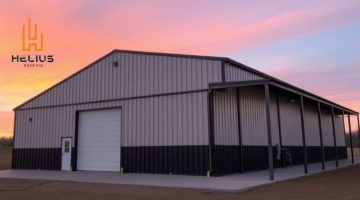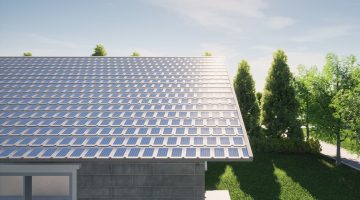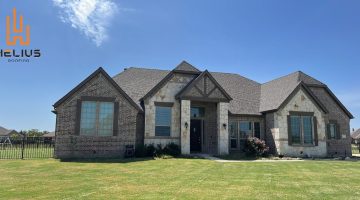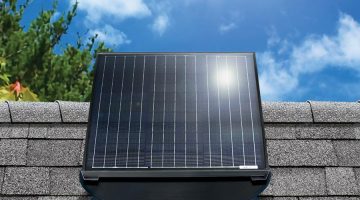By Helius Roofing & Construction
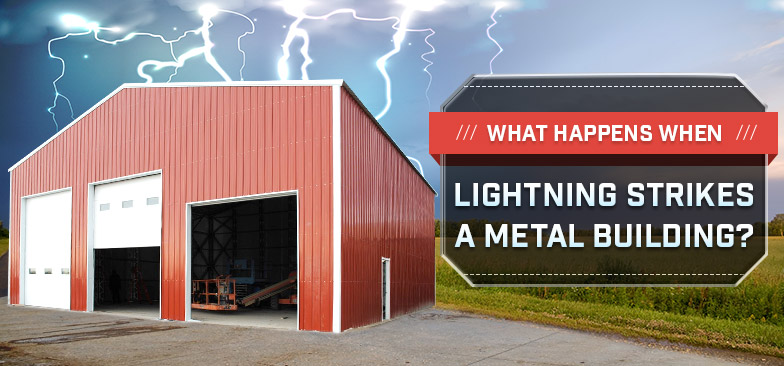
Metal buildings have become a popular choice for residential, commercial, and industrial uses due to their durability, affordability, and versatility. However, because metal is a highly conductive material, many people wonder what happens if a metal building gets hit by lightning. Does the metal attract lightning? Will the building catch fire or suffer significant damage? In this article, we’ll explore the effects of lightning strikes on metal buildings, dispel common myths, and discuss how to protect your metal structure from lightning damage.
Do Metal Buildings Attract Lightning?
One of the most common myths about metal buildings is that they attract lightning more than other types of structures. In reality, this isn’t true. Lightning is drawn to the highest point in an area, not necessarily to materials like metal. Tall trees, poles, or buildings are more likely to be struck by lightning based on their height and position, rather than their composition.
Metal as a Conductor
While metal does not attract lightning, it is an excellent conductor of electricity. This means that if a lightning bolt strikes a metal building, the electrical charge will travel through the metal structure and into the ground. This can actually be beneficial, as the building will direct the energy away from occupants and valuable equipment inside.
In other words, the metal structure of a building acts similarly to a Faraday cage—a protective enclosure that distributes electrical charge around its surface, keeping the interior safe from harm.
What Happens During a Lightning Strike?
When lightning strikes a building, it releases a massive amount of energy—up to one billion volts of electricity in a single bolt. If a metal building gets hit by lightning, the following things can happen:
1. Electrical Charge Travels Through the Structure
The conductive properties of metal allow the electrical charge from a lightning strike to travel through the building’s frame, walls, and roof. This charge will then continue into the ground through a grounding system (if one is properly installed). Because the energy is quickly dispersed through the structure, the interior of the building and its occupants are typically protected from the worst effects of the strike.
2. Possible Damage to Electrical Systems
Although the metal structure can protect the building itself from severe damage, the electrical systems inside the building may still be at risk. Lightning can cause power surges that damage electrical wiring, appliances, and sensitive equipment. This is particularly concerning in industrial or commercial metal buildings where expensive machinery or technology is in use.
To protect against this, surge protectors should be installed to safeguard electrical systems. Proper grounding of the building’s electrical system can also help prevent damage by providing a safe path for the electrical current to travel.
3. Fire Risk from Secondary Sources
While a metal building itself is highly resistant to fire, secondary effects of a lightning strike could pose a fire risk. For instance, if lightning strikes nearby objects like trees, flammable materials, or gas lines, it could ignite a fire that spreads to the metal building. Additionally, if the building is not properly grounded, there is a chance that a lightning strike could cause sparks that lead to electrical fires inside the structure.
4. Structural Damage
In rare cases, lightning strikes can cause physical damage to a metal building. Although metal is strong and durable, the intense heat generated by a lightning strike can sometimes cause warping or melting in thin sections of the metal, especially if the structure is not properly grounded. The risk of structural damage is higher in metal buildings with exposed wiring or inadequate lightning protection systems.
Lightning Protection Systems for Metal Buildings
The best way to protect your metal building from lightning is by installing a lightning protection system. These systems are designed to safely conduct the electrical energy from a lightning strike into the ground, preventing damage to the building, its occupants, and its contents.
1. Grounding Systems
Proper grounding is essential for any metal building. Grounding ensures that the electrical charge from a lightning strike is safely directed into the earth, where it dissipates without causing harm to the building or its occupants.
How Grounding Works
A grounding system typically consists of conductive rods that are buried deep in the ground around the perimeter of the building. These rods are connected to the building’s frame using conductive cables, creating a low-resistance pathway for electrical energy to travel. When lightning strikes the building, the electrical charge follows this path and is safely absorbed by the ground, minimizing the risk of damage.
Grounding Best Practices
To ensure effective protection, it’s crucial that grounding systems are installed correctly by licensed professionals. The grounding rods should be made from high-quality, corrosion-resistant materials like copper or galvanized steel. It’s also important to periodically inspect and maintain the grounding system to ensure that it continues to function properly over time.
2. Lightning Rods
Another common component of lightning protection systems is the lightning rod. These are metal rods installed on the roof or other high points of the building. The purpose of a lightning rod is to attract lightning and safely direct the electrical charge into the ground.
How Lightning Rods Work
When lightning strikes, it is naturally drawn to the highest point in the area. A lightning rod installed on a metal building will attract the strike and provide a direct path for the electrical charge to travel safely into the grounding system. By controlling where the lightning hits, a lightning rod reduces the likelihood of damage to other parts of the building.
3. Surge Protection Devices
Surge protection devices (SPDs) are another important element of a lightning protection system. These devices are designed to protect the building’s electrical systems from the power surges caused by a lightning strike.
How Surge Protectors Work
SPDs are installed at key points in the building’s electrical system, such as the main electrical panel or near sensitive equipment. When lightning causes a surge in the electrical current, the surge protector absorbs or redirects the excess voltage, preventing it from reaching and damaging connected devices.
Importance of Surge Protection
In metal buildings that house expensive machinery, computer systems, or other sensitive equipment, surge protection is essential. Without it, a single lightning strike could lead to thousands of dollars in damage and downtime for repairs.
Benefits of Metal Buildings in Lightning-Prone Areas
While lightning strikes can be a concern for any building, metal structures offer several advantages in lightning-prone areas.
1. Built-in Lightning Protection
Because metal is a natural conductor of electricity, metal buildings are often inherently safer during lightning storms than structures made from non-conductive materials like wood or brick. The conductive nature of metal allows lightning to flow through the building without causing significant harm, provided the structure is properly grounded.
2. Fire Resistance
Unlike wooden structures, which can catch fire easily when struck by lightning, metal buildings are non-combustible. This greatly reduces the risk of fire during a lightning storm. Even if nearby objects catch fire due to a strike, the metal building itself will not ignite.
3. Structural Durability
Metal buildings are designed to withstand extreme weather conditions, including strong winds, heavy rain, and lightning strikes. When combined with proper grounding and lightning protection systems, metal buildings are among the safest choices for regions prone to lightning storms.
Conclusion
While metal buildings do not attract lightning more than any other structure, their conductive properties make them safer in the event of a strike, as long as the building is properly grounded and equipped with a lightning protection system. By safely directing electrical energy into the ground, metal buildings can protect occupants, equipment, and the structure itself from serious damage. For those living or working in areas prone to lightning storms, a metal building with a professionally installed lightning protection system can provide peace of mind and long-lasting security.
At Helius Roofing & Construction, we specialize in building durable, weather-resistant metal structures. We can also help you implement effective lightning protection systems to ensure your building remains safe during storms. Contact us today to learn more about how we can help protect your metal building from lightning damage.


